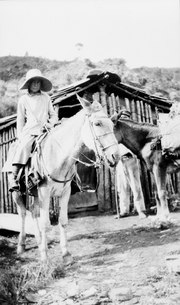Main Page (original) (raw)
Explore Wikispecies
- HELP Section – Detailed information on creating pages.
- Taxonomy – Information on the Linnaean classification of species.
- Village Pump – Discuss the project.
- Done and To Do – See references to very detailed areas and defined future targets
- Wikispecies FAQ – Check replies to common concerns.
- Image Guidelines – Our recommendation on where to upload illustrations
- Wikispecies PR – Help us by spreading the word of Wikispecies
Collaboration with ZooKeys
A collaboration between Wikispecies and ZooKeys has been announced. PhytoKeys also joined the collaboration in November 2010. Images of species from ZooKeys and PhytoKeys will be uploaded to Wikimedia Commons and used in Wikispecies.
Mary Agnes Chase
1869–1963. Standard IPNI form: Chase
Mary Agnes Chase, née Merrill, was an American botanist who worked at the U.S. Department of Agriculture and the Smithsonian Institution. She is considered one of the world's outstanding agrostologists and is known for her work on the study of grasses, and also for her work as a suffragist. Chase was born in Iroquois County, Illinois and held no formal education beyond grammar school. That aside, she made significant contributions to the field of botany, authored over 70 scientific publications, and was conferred with an honorary doctorate in science from the University of Illinois. She specialized in the study of grasses and conducted extensive field work in North- as well as and South America. Her Smithsonian Field Books collection from 1897 to 1959 is archived in the Smithsonian Institution Archives.
In 1901, Chase became a botanical assistant at the Field Museum of Natural History under Charles Frederick Millspaugh, where her work was featured in two museum publications: Plantae Utowanae (1900) and Plantae Yucatanae (1904). Two years later, Chase joined the U.S. Department of Agriculture (USDA) as a botanical illustrator and eventually became a scientific assistant in systematic agrostology (1907), assistant botanist (1923), and associate botanist (1925), all under Albert Spear Hitchcock. Chase worked with Hitchcock for almost twenty years, collaborating closely and also publishing, for instance The North American Species of Panicum (1910).
Following Hitchcock's death in 1936, Chase succeeded him to become senior botanist in charge of systematic agrostology and custodian of the Section of Grasses, Division of Plants at the United States National Museum (USNM). Chase retired from the USDA in 1939, but continued her work as custodian of the USNM grass herbarium until her death in 1963. She was an Honorary Fellow of the Smithsonian Institution (1959) and Fellow of the Linnean Society of London (1961). Agnesia is named in her honour (a monotypic genus of herbaceous South American bamboo in the grass family).
Chase experienced discrimination based on her gender in the scientific field, for example, being excluded from expeditions to Panama in 1911 and 1912 because the expedition's benefactors feared the presence of women researchers would distract men. During World War I, Chase marched with Alice Paul and was jailed several times for her activities. In 1918, she was arrested at the Silent Sentinels rally picketing the White House; she refused bail and was held for 10 days, where she instigated a hunger-strike and was force-fed. The USDA accused her of "conduct unbecoming a government employee," but Hitchcock helped her keep her job. Chase was also an active member of the National Association for the Advancement of Colored People (NAACP).
See also: Distinguished authors of previous months.
Species of the month
Long-toed salamander
Ambystoma macrodactylum Baird, S.F. 1850
Some facts about this mole salamander in the family Ambystomatidae:
Length: Typically 4.1–8.9 cm (1.6–3.5 in) when mature
Range: The distribution of the long-toed salamander is primarily in the Pacific Northwest, Western North America, with an altitudinal range of up to 2,800 m (9,200 ft).
Type locality: "Astoria, [Clatsop County,] Oregon", USA.
Habitat: The Long-toed salamander lives in a variety of habitats, including temperate rainforests, coniferous forests, montane riparian zones, sagebrush plains, red fir forests, semiarid sagebrush, cheatgrass plains, and alpine meadows along the rocky shores of mountain lakes. It lives in slow-moving streams, ponds, and lakes during its aquatic breeding phase. The long-toed salamander hibernates during the cold winter months, surviving on energy reserves stored in the skin and tail.
First described: By the American naturalist and museum curator Spencer Fullerton Baird in 1850.
Conservation status: Not threatened.
While the long-toed salamander is classified as Least Concern (LC) by the IUCN, many forms of land development negatively affect the salamander's habitat and have put new perspectives and priorities into its conservation biology. Conservation priorities focus at the population level of diversity, which is declining at rates ten times that of species extinction. Population level diversity is what provides ecosystem services, such as the keystone role that salamanders play in the soil ecosystems, including the nutrient cycling that supports wetland and forested ecosystems.
The subspecies Ambystoma macrodactylum croceum Russell & Anderson, 1956 (Santa Cruz Long-toed Salamander) is of particular concern and it was afforded protections in 1967 under the US Endangered Species Act. This subspecies lives in a narrow range of habitat in Santa Cruz County and Monterey County, California. Prior to receiving protections, some few remaining populations were threatened by development. The subspecies is ecologically unique, having unique and irregular skin patterns on its back, a unique moisture tolerance, and it is also an endemic that is geographically isolated from the rest of the species range. Ambystoma macrodactylum croceum is considered Critically Imperiled (T1) by the NatureServe conservation status system.
See also: Species of previous months.



